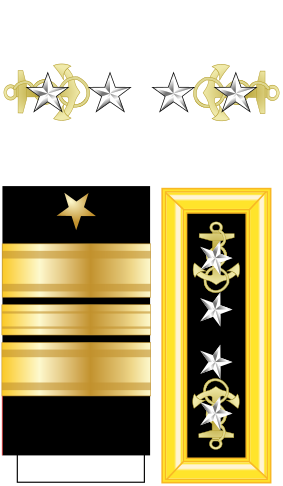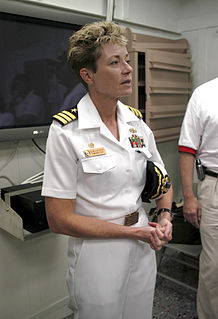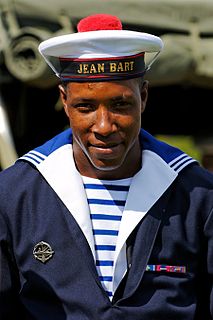 W
WIn the United States Navy, a rate is the military rank of an enlisted sailor, indicating where an enlisted sailor stands within the chain of command, and also defining one's pay grade. However, in the U.S. Navy, only officers carry the term rank, while it is proper to refer to an enlisted sailor's pay grade as rate. The same term also refers to one's area of occupational specialization within the enlisted Navy. Associated with the enlisted pay grades is a numbering system from the most junior enlisted sailor ("E-1") to the most senior enlisted sailor ("E-9"). This enlisted numbering system is the same across all five branches of the U.S. military. All E-1 through E-3 are known as seamen. E-4 through E-6 are called petty officers. All E-7s are called chief petty officer, E-8s senior chief petty officer, and E-9s master chief petty officer. Rates are displayed on a rating badge, which is a combination of rate and rating. E-2s and E-3s have color-coded group rate marks based on their career field. Personnel in pay grade E-1, since 1996, do not have an insignia to wear.
 W
WThe Admiral of the Navy is the highest possible rank in the United States Navy. The rank is equated to that of a six-star admiral and is one of the two highest possible military ranks in the United States Armed Forces. It has only been awarded once, to George Dewey, in recognition of his victory at Manila Bay in 1898.
 W
WIn the United States Navy, United States Coast Guard, United States Public Health Service Commissioned Corps (USPHS), and National Oceanic and Atmospheric Administration Commissioned Officer Corps, captain is the senior-most commissioned officer rank below that of flag officer. The equivalent rank is colonel in the United States Army, Air Force, and Marine Corps.
 W
WChief petty officer (CPO) is the seventh Enlisted rank in the United States Navy and U.S. Coast Guard, just above petty officer first class and below senior chief petty officer. The term rate is used to identify the career field of a Chief Petty Officer. For example the rate of Master-at-Arms in the rank of Chief Petty Officer would be spoken as Master-at-Arms, Chief Petty Officer or Master-at-Arms Chief. Additionally it would be officially written MAC, USN/R. The grade of chief petty officer was established on 1 April 1893 for the United States Navy. The United States Congress first authorized the Coast Guard to use the promotion to chief petty officer on 18 May 1920. Chief petty officer is also the final cadet grade in the United States Naval Sea Cadet Corps.
 W
WCommand master chief petty officer (CMDCM) is an enlisted rating in the United States Navy and U.S. Coast Guard, as well as the Japan Maritime Self-Defense Force.
 W
WIn the United States, commander is a military rank that is also sometimes used as a military billet title—the designation of someone who manages living quarters or a base—depending on the branch of service. It is also used as a rank or title in non-military organizations; particularly in law enforcement.
 W
WFleet admiral is a five-star flag officer rank in the United States Navy whose rewards uniquely include active duty status for life. Fleet admiral ranks immediately above admiral and is equivalent to General of the Army and General of the Air Force. Although it is a current and authorized rank, no U.S. Navy officer presently holds it, with the last U.S. Navy fleet admiral being William D. Leahy, who was promoted to the rank in December 1944 and retired in March 1949. The last person to be promoted to the rank was William Halsey Jr. who was promoted to the rank in December 1945.
 W
WLieutenant , commonly abbreviated as LTJG or, historically, Lt. (j.g.), is a junior commissioned officer rank of the United States Navy, the United States Coast Guard, the United States Public Health Service Commissioned Corps, and the National Oceanic and Atmospheric Administration Commissioned Officer Corps. LTJG has a US military pay grade of O-2, and a NATO rank code of OF-1a. The rank is also used in the United States Maritime Service. The NOAA Corps's predecessors, the United States Coast and Geodetic Survey Corps (1917–1965) and the Environmental Science Services Administration Corps or ESSA Corps (1965–1970), also used the rank.
 W
WThe military rank of lieutenant, in the United States Navy, United States Coast Guard, National Oceanic and Atmospheric Administration Commissioned Officer Corps (NOAA-COO), and United States Public Health Service Commissioned Corps (PHS-CC), the rank of lieutenant is divided between:Lieutenant (O-3), equivalent to a Captain in the U.S. Army, Air Force & Marines Lieutenant junior grade (O-2), sometimes referred as "lieutenant j.g."
 W
WLieutenant commander (LCDR) is a mid-ranking officer rank in the United States Navy, the United States Coast Guard, the United States Public Health Service Commissioned Corps, and the National Oceanic and Atmospheric Administration Commissioned Officer Corps, with the pay grade of O-4 and NATO rank code OF-3. The predecessors of the NOAA Corps, the United States Coast and Geodetic Survey Corps (1917–1965) and the Environmental Science Services Administration Corps (1965–1970), also used the lieutenant commander rank, and the rank is also used in the United States Maritime Service and the United States Naval Sea Cadet Corps. Lieutenant commanders rank above lieutenants and below commanders, and rank is equivalent to a major in the United States Army, United States Air Force, and United States Marine Corps.
 W
WThe master, or sailing master, was a historical rank for a naval officer trained in and responsible for the navigation of a sailing vessel. The rank can be equated to a professional seaman and specialist in navigation, rather than as a military commander.
 W
WPetty officer first class (PO1) is a rank found in some navies and maritime organizations. It is the sixth enlisted rate in the United States Navy, U.S. Coast Guard, and the U.S. Naval Sea Cadet Corps, ranking just above petty officer second class and directly below chief petty officer. It is designated as non-commissioned officer, as are all petty officer ratings. It is equivalent to the rank of staff sergeant in the Army and Marine Corps, and technical sergeant in the Air Force. They are all ranked E-6, which refers to the enlisted numbering system associated with pay grades.
 W
WPetty officer second class is the fifth enlisted rank in the U.S. Navy, U.S. Coast Guard, and the United States Naval Sea Cadet Corps, just above petty officer third class and below petty officer first class, and is a non-commissioned officer. It is equivalent to the rank of sergeant in the Army and Marine Corps, and staff sergeant in the Air Force.
 W
WA rear admiral in the US uniformed services is either of two different ranks of commissioned officers: one-star flag officers and two-star flag officers. By contrast, in most nations, the term "rear admiral" refers to an officer of two-star rank.
 W
WA rear admiral in the US uniformed services is either of two different ranks of commissioned officers: one-star flag officers and two-star flag officers. By contrast, in most nations, the term "rear admiral" refers to an officer of two-star rank.
 W
WSeaman is a military rank used in many navies around the world. It is considered a junior enlisted rank and, depending on the navy, it may be a single rank on its own or a name shared by several similarly-junior ranks.
 W
WSeaman recruit (SR) is the lowest enlisted rate in the United States Navy, U.S. Coast Guard, and the U.S. Naval Sea Cadet Corps just below seaman apprentice; this rank was formerly known as seaman third class. Two separate pay grades exist within this rank — one for those with service of less than four months, with a higher pay scale for those in service for more than four months, even if they have not yet advanced to seaman apprentice.
 W
WIn the United States Armed Forces, the ranks of warrant officer are rated as officers above all non-commissioned officers, candidates, cadets, and midshipmen, but subordinate to the lowest officer grade of O‑1. This application differs from the Commonwealth of Nations and other militaries, where warrant officers are the most senior of the other ranks, equivalent to the U.S. Armed Forces grades of E‑8 and E‑9.